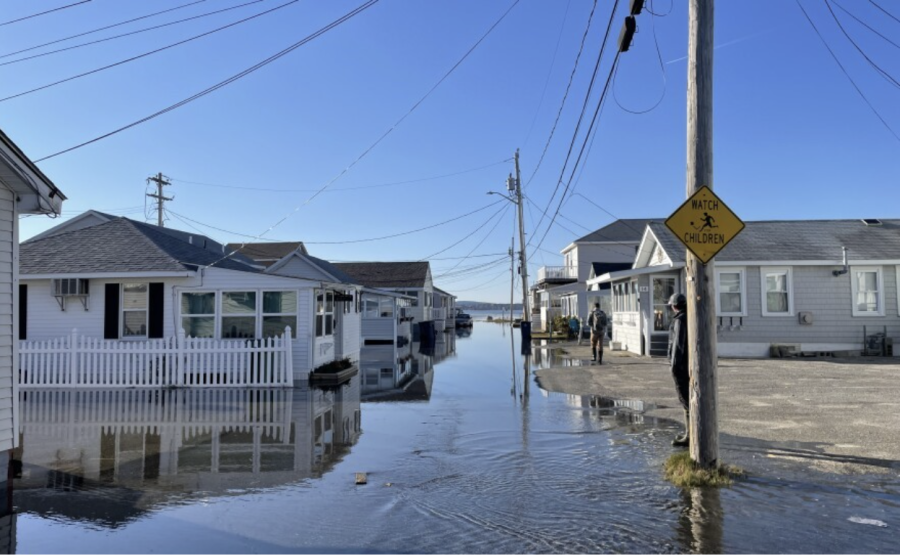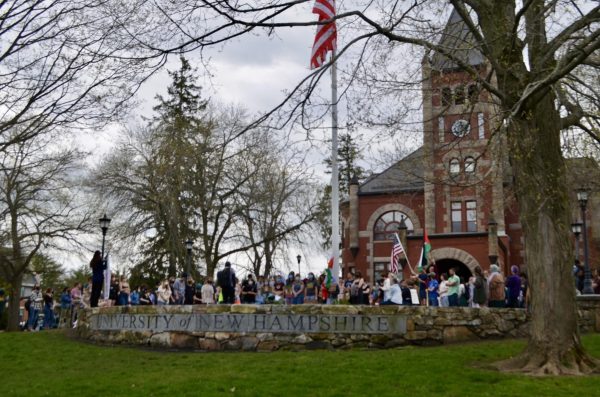New Hampshire’s cities on the frontline of worsening climate crisis
May 12, 2022
After the United States experienced its hottest summer on record last year, the country is poised for more record-breaking heatwaves as climate change worsens. New Hampshire’s infrastructure is being tested by this rapidly changing climate crisis as rising sea, groundwater levels, precipitation, and heat threaten public works. While the Biden administration has taken positive steps to address this issue, local municipalities find themselves at the forefront of the fight against climate change.
In 2020, global sea levels reached a new record high of 3.6 inches more than 1993 levels. Over 32% of New Hampshire’s population lives in high-density coastline communities, which leaves towns like Hampton and Portsmouth at risk. These areas have already faced rising coastlines that have flooded basements, homes, and roads.
Hampton was already impacted earlier this year as flood tides overtook Route 1, Ashworth Avenue, and side streets like Auburn and Perkins Avenue. Hampton Town Planner Jason Bachand believes this could only be the start.
“Certain roadways could be cut off by coastal flooding in the next 10, 20, 30 years,” Bachand said.
He thinks these first-hand experiences with flooding have caused residents to take the issue more seriously, with some elevating their homes above the base flood level.
A similar situation is unfolding in Portsmouth as city officials discuss elevating the road connecting to the Portsmouth Wastewater Treatment Plant on Pierce Island. If this route was cut-off, the city’s sewer system would likely shut down.
Portsmouth Environmental Planner/Sustainability Coordinator Peter Britz identified Strawbery Banke, Prescott Park, and Mechanic Street as areas of concern as they are some of the lowest parts of the city. Strawbery Banke, which contains the majority of Portsmouth’s historic district, is already experiencing severe basement flooding.
Portsmouth has begun plotting the potential financial costs of rising water levels for Strawbery Banke and Prescott Park. A city report concluded that if the sea level rises 7.5 feet more than the average, costs could range from $103,000 for building adaption/relocation or an estimated $3 million for a tide barrier and its operational fees. Should the sea level rise double, costs could range from $2,400,000 for raising buildings or $11.3 billion for a tide barrier and floodwall plus its operational fees.
“As a municipal government, we’re always worried about cost,” said Britz. “[But] it’s pretty understood that if we can do stuff in advance, we’re going to save money in the long run.”
While sea level increases at this rate aren’t an immediate concern, Britz is worried about climate change’s impact on the local economy. This fear is also shared by New Hampshire’s other coastal communities.
“Issues like climate change and coastal flooding, they all affect various things,” said Bachand. “Whether it be housing, economic development. It’s all interwoven.”
However, waterfront communities like Hampton and Portsmouth are more likely to have a robust economy due to tourism, resulting in higher tax revenues. This may help them combat the impact of climate change, according to UNH Professor of Geography Jennifer Brewer, who specializes in environmental policy. She explained there has been a long history of poorer communities, usually populated by people of color, being built in floodplains which places residents at a much higher risk.
“The long-term financial costs are potentially devastating. And who will pay those costs in both financial and human terms?” said Brewer. “There’s no question that the wealthiest few will be less impacted. There’s no question.”
However, coastal flooding is not the only water-related issue. New Hampshire cities also have to contend with the rise of groundwater, which is water held in the soil or in pores and crevices in rock. As sea levels rise, groundwater will continually be pushed up to the surface as saltwater is denser than freshwater.
According to University of New Hampshire (UNH) Professor of Civil and Environmental Engineering Jennifer Jacobs, most damage is not caused by water sitting on top of the road but rather water rising underneath. This is what causes “alligator cracking” in the pavement. What makes this especially problematic for New Hampshire cities is alligator cracking doesn’t have a simple solution. Ultimately, the area has to be saw cut to find the cause or be removed completely.
This evaluation process can lead to blockages as cities have to take time to repair or replace these roads. increased need for repairs would severely impact travel as at least 115 million cars and trucks hit American streets every day.
Another cause of groundwater rise is increased precipitation. Since 2005, New Hampshire has experienced 6.8 inches of rain more than the previous average.
“Small, high-intensity rainfall events are fairly localized. And we’re expecting that to continue and to get worse,” said Jacobs. She explained that this will mostly impact rural areas such as the Great Lakes or the Hanover region.
This raises the issue of how lower-income and rural communities are going to deal with adjusting their infrastructure for the increased rainfall. Nathalie DiGeronimo, the resilience project manager for the state’s Coastal Program, identified culverts (such as drainage pipes) as an area of concern. Many will need to be enlarged to prevent flooding, which is not only more expensive itself but installation brings additional costs which these communities cannot afford as easily.
While New Hampshire towns can apply for federal programs to help fund these projects, they often require a contribution from the community. The Federal Emergency Management Agency’s (FEMA) Hazard Mitigation assistance requires towns to pay 50% – 75% of the project’s fees, which can be impossible for some areas, according to DiGeronimo. This is further complicated in smaller, poorer regions that may not have the resources to apply for the programs in the first place.
“We’re trying to get more creative and how we can both help distribute the fundings that we have available more equitably, but also to enhance the capacity of these communities to apply,” said DiGeronimo. She explained that a simple application is offered so these areas can receive additional staff assistance to help apply for larger grant programs.
However, this still does not negate the cost issue. Some towns, such as Dover and Concord, have been considering implementing Stormwater and Flood Resilience Utilities that would collect fees in relation to the amount of impervious cover on a property. Impervious cover is any surface that can’t absorb rainfall, including driveways, roads, and parking lots.
“There needs to be a way to pay for this work. How are we going to do this work? And it’s not something that’s typically planned for, so it’s outside the realm of the regular budget process,” Britz said. Another hurdle is cities have to bring these costs forward as part of a new budget, bringing challenges at the municipal level.
Increasing temperatures across the state are also stressing cities and budgets. In 2021, NHPR reported New Hampshire experienced more days over 90 degrees as well as higher average and overnight temperatures in the summers over the past 50 years. Without cooler” temperatures at night, prolonged heat can negatively affect road integrity, cooling systems, and human health, according to Jacobs.
Both tarmac and asphalt can soften under extreme heat, causing cars to leave grooves. This not only compromises the roads but vehicles traveling on them which is of greater concern with heavier vehicles like supply trucks. The COVID-19 pandemic has seen extreme delays all along the supply chain due to virus outbreaks, and the possibility of further damage to roadways would only worsen the problem.
“All it takes is one big supply truck at the wrong time,” said Jacobs.
There is no easy solution as it is difficult to create road material that can handle the extreme temperatures of New England seasons. If manufacturers aim to combat one area, they’ll be compromising road integrity in other ways, she warned.
“It is not that we don’t have the solutions. We have the solutions. We can fix this,” Brewer said. “We need to do it really, really fast. Faster than we thought. Faster than we would like to. The question is, is mobilizing the political will to get it done.”
Photo Courtesy of Mara Hoplamazian For NHPR.





























